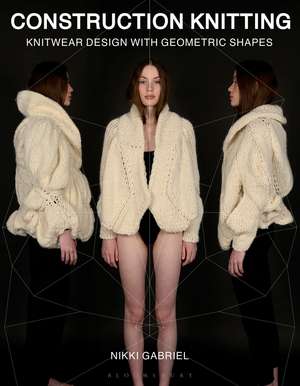Construction Knitting: Knitwear Design With Geometric Shapes
Autor Nikki Gabrielen Limba Engleză Hardback – 6 mar 2024
Preț: 606.99 lei
Preț vechi: 705.81 lei
-14% Nou
Puncte Express: 910
Preț estimativ în valută:
116.15€ • 126.56$ • 97.87£
116.15€ • 126.56$ • 97.87£
Carte disponibilă
Livrare economică 02-16 aprilie
Preluare comenzi: 021 569.72.76
Specificații
ISBN-13: 9781472575746
ISBN-10: 1472575741
Pagini: 208
Ilustrații: 300 colour illus.
Dimensiuni: 210 x 270 x 25 mm
Greutate: 1 kg
Editura: Bloomsbury Publishing
Colecția Bloomsbury Visual Arts
Locul publicării:London, United Kingdom
ISBN-10: 1472575741
Pagini: 208
Ilustrații: 300 colour illus.
Dimensiuni: 210 x 270 x 25 mm
Greutate: 1 kg
Editura: Bloomsbury Publishing
Colecția Bloomsbury Visual Arts
Locul publicării:London, United Kingdom
Caracteristici
With patterns of garment prototypes that a reader can design-modify by applying the variables as set out in the book
Notă biografică
Nikki Gabriel is a knitwear and textile designer. Nikki initially trained at the Royal Melbourne Institute of Technology (RMIT), Australia, and now runs her own business based in Napier, New Zealand, designing knitwear and knitting patterns. She also has her very own brand of yarn, Wooli. Nikki's approach to hand-making is about building structures that experiment with techniques and form, and through this process she produces stylish, constructed knitting designs that each wearer can render completely unique.
Cuprins
SECTION ONEKnitting Techniques1 Knitting Techniques1.1 Hand Knitting, overview.1.1.1 Tools and Mechanics for Hand Knitting1.1.2 Types, classification and identification of yarns, fibres and fabrics for hand knitting.1.2 Machine Knitting, overview.1.2.1 Tools and Mechanics for Machine Knitting1.2.2 Types, classification and identification of yarns, fibres and fabrics for machine knitting.1.3.1 Industrial Knitting, overview1.3.2 Tools and Mechanics for Industrial Knitting1.3.3 Types, classification and identification of yarns, fibres and fabrics for industrial knitting methods.1.4 Fabric, yarn and fibre Properties1.5 Fabric, yarn and fibre Structure SECTION TWOConstruction Knitting Theory2.1 Elements and Principals of Design2.1.1 Construction Knitting relative to Classic Design Principles2.1.2 Knitting Geometric Shapes for Construction Knitting2.2 Shapes and the Human Form2.2.1 Mapping out a Construction Plan following the contour of the Human Form.2.2.2 Creating an Accumulative Grid Pattern2.2.3 Flat and Drape Patternmaking Techniques relative to the Construction Knitting Method.2.2.4 Line, Shape and Silhouette2.2.4 Accumulative Grid pattern designs.2.2.5 Proportions, Repetition & Rythmn2.3 The Creative Process2.3.1 Intuition and Play based on the Construction Knitting method2.3.2 Gesture in Design / Colour, Texture and Contrast. SECTION THREEPractical suggestions of creating designs based on model building using geometric shapes.3.1 Squares3.1.1 Attributes of the Square used in Design.3.1.2 Knitted squares by hand, machine and digital methods.3.1.3 Using squares in accumulative construction grid patterns.3.1.4 Developing 2D flat pattern designs using squares.3.1.5 Developing 3D drape pattern designs using squares.3.2 Triangles3.2.1 Attributes of the Triangle used in Design.3.2.2 Knitted triangles by hand, machine and digital methods.3.2.3 Using triangles in accumulative construction grid patterns.3.2.4 Developing 2D flat pattern designs using triangles.3.2.5 Developing 3D drape pattern designs using triangles.3.3 Circles3.3.1 Attributes of the Circle used in Design.3.3.2 Knitted circles by hand, machine and digital methods.3.3.3 Using circles in accumulative construction grid patterns.3.3.4 Developing 2D flat pattern designs using circles.3.3.5 Developing 3D drape pattern designs using circles. 4. REFERENCE4.1 Calculating yarn substitutions4.2 Aust/NZ/US/European glossary4.3 Aust/NZ/US/European weight charts4.4 Aust/NZ/US/European knitting needle charts4.5 Resources (includes yarn companies and web resources for yarn, fibre and knitting information)5. INDEX6. BIBLIOGRAPHY7. ACKNOWLEDGEMENTS
